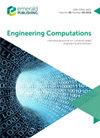Continuous composite longitudinal fins under oscillating boundary conditions: a lattice Boltzmann solution
IF 1.5
4区 工程技术
Q3 COMPUTER SCIENCE, INTERDISCIPLINARY APPLICATIONS
引用次数: 0
Abstract
PurposeTransient response of continuous composite material (CCM) fin made of high thermally conductive composite material is presented. The continuously varying effective properties of composite material such as thermal conductivity, heat capacity and density have been modelled using the Mori-Tanaka homogenization theory and rule of mixture. Additionally, temperature dependency of thermal conductivity, heat generation (composite materials) and convection coefficient (fluid properties) have also been incorporated. Different base boundary conditions are addressed such as oscillating heat flow, oscillating temperature, step-changing heat flow and step-changing temperature. At the other boundary, the fin is assumed to have a convective tip.Design/methodology/approachLattice Boltzmann method is implemented using an in-house source code for obtaining the numerical solution of typical non-linear heat balance equation of the aforementioned problem under various transient base boundary conditions.FindingsThe effects of various thermal parameters such as material diffusivity ratio and conductivity ratio, area ratio and Biot number on transient response of fin and temperature distribution of fins are studied and interpreted. The heat transfer rate and time for attainment of steady state temperature of metal matrix composite (MMC) fin are found to be proportionally dependent on their diffusivity ratio. Additionally for higher values of area ratio and biot number, MMC fins are reported to dissipate the heat more efficiently in comparision to homogeneous fins in terms of time required to attain the steady state and surface temperature.Practical implicationsResponse of transient fin associated with advanced class of material can facilitates the practicing engineers for designing high-performance and/or miniaturized thermal management devices as used in electronic packaging industries.Originality/valueStudies of composite fin consisting of laminating second layer of material over the first layer have been reported previously, however transient response of CCM fin fabricated by continuously varying the volume fraction of two materials along the fin length has not been reported till date. Such material finds its application in thermal management and electronic packaging industries. Results are plotted in form of a graph for different application-wise material combinations that have not been reported earlier, and it can be treated as design data.振荡边界条件下的连续复合纵向翅片:晶格玻尔兹曼解法
目的 介绍了由高导热复合材料制成的连续复合材料(CCM)翅片的瞬态响应。利用 Mori-Tanaka 均质化理论和混合规则对复合材料连续变化的有效特性(如导热系数、热容量和密度)进行了建模。此外,热导率、发热量(复合材料)和对流系数(流体特性)也与温度有关。研究了不同的基本边界条件,如振荡热流、振荡温度、阶跃变化热流和阶跃变化温度。研究结果研究并解释了各种热参数(如材料扩散比和传导比、面积比和比奥特数)对翅片瞬态响应和翅片温度分布的影响。研究发现,金属基复合材料(MMC)翅片的传热速率和达到稳态温度的时间与材料的扩散率成正比。此外,当面积比和比奥特数越高时,MMC 翅片的散热效率越高,达到稳态温度和表面温度所需的时间也越长。原创性/价值之前已有关于在第一层材料上层叠第二层材料的复合翅片的研究报道,但迄今为止还没有关于通过沿翅片长度连续改变两种材料的体积分数来制造 CCM 翅片的瞬态响应的报道。这种材料可应用于热管理和电子封装行业。本文以图表的形式绘制了不同应用领域的材料组合结果,这些结果此前从未报道过,因此可将其视为设计数据。
本文章由计算机程序翻译,如有差异,请以英文原文为准。
求助全文
约1分钟内获得全文
求助全文
来源期刊

Engineering Computations
工程技术-工程:综合
CiteScore
3.40
自引率
6.20%
发文量
61
审稿时长
5 months
期刊介绍:
The journal presents its readers with broad coverage across all branches of engineering and science of the latest development and application of new solution algorithms, innovative numerical methods and/or solution techniques directed at the utilization of computational methods in engineering analysis, engineering design and practice.
For more information visit: http://www.emeraldgrouppublishing.com/ec.htm
 求助内容:
求助内容: 应助结果提醒方式:
应助结果提醒方式:


